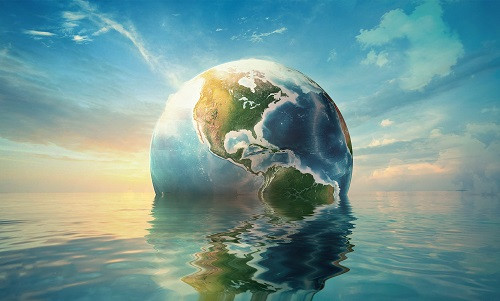Earth’s Oceans Were Not Always Blue — They Were Once Green, Say Scientists

IIE Digital Desk :Scientists have discovered that the oceans we now know to be deep blue were once green — a change linked to the planet’s evolving chemistry and lifeforms over billions of years.
This finding, which emerged from recent geological and biochemical research, provides new insights into the ancient conditions of our planet and the transformative role of microbial life. The color of Earth's oceans has long been associated with the scattering of sunlight and the absorption characteristics of water. However, scientists now believe that the oceans' hue also depended heavily on the chemical composition of seawater and the presence (or absence) of oxygen.
According to the study, which analyzed ancient marine sediments dating back over 2.5 billion years, Earth's oceans were rich in iron and lacked the oxygen that characterizes our modern atmosphere. In these anoxic conditions, iron would dissolve into the seawater and give it a greenish tint, similar to how iron-rich lakes appear green today.
The turning point came during the Great Oxidation Event, which occurred around 2.4 billion years ago. This dramatic shift in Earth’s atmosphere — triggered by the activity of cyanobacteria that began producing oxygen through photosynthesis — led to a massive transformation. As oxygen began to accumulate, it reacted with the dissolved iron in the oceans, forming insoluble iron oxides that settled to the ocean floor. These deposits are visible today as banded iron formations in ancient rocks.
As iron levels dropped and oxygen levels rose, the oceans began to transition from green to blue. This transformation not only changed the color of the seas but also paved the way for more complex life to evolve. The increased oxygen allowed for aerobic respiration — a more efficient way of generating energy — setting the stage for multicellular organisms and, eventually, animals.
Dr. Jennifer Glass, a geochemist at Georgia Tech and one of the study’s lead authors, explained: “We often think of Earth’s oceans as timelessly blue, but our planet's history is marked by sweeping environmental changes. The green oceans of early Earth tell us a story of a world dominated by microbial life and devoid of the oxygen that now sustains complex ecosystems.”
Understanding the changing colors of Earth’s oceans isn't just a curiosity about the past — it also has implications for the search for life beyond our planet. Scientists studying exoplanets and their atmospheres often look for biosignatures — chemical markers like oxygen and methane. Knowing that Earth's own biosphere went through dramatic chemical transitions helps refine models of what alien life might look like, or what signs of life we should be looking for in distant planetary systems.
The study serves as a reminder that Earth’s current conditions — including its blue oceans and breathable atmosphere — are the product of deep, dynamic changes. It highlights the intimate connection between the planet’s chemistry and the life it supports.
You might also like!















